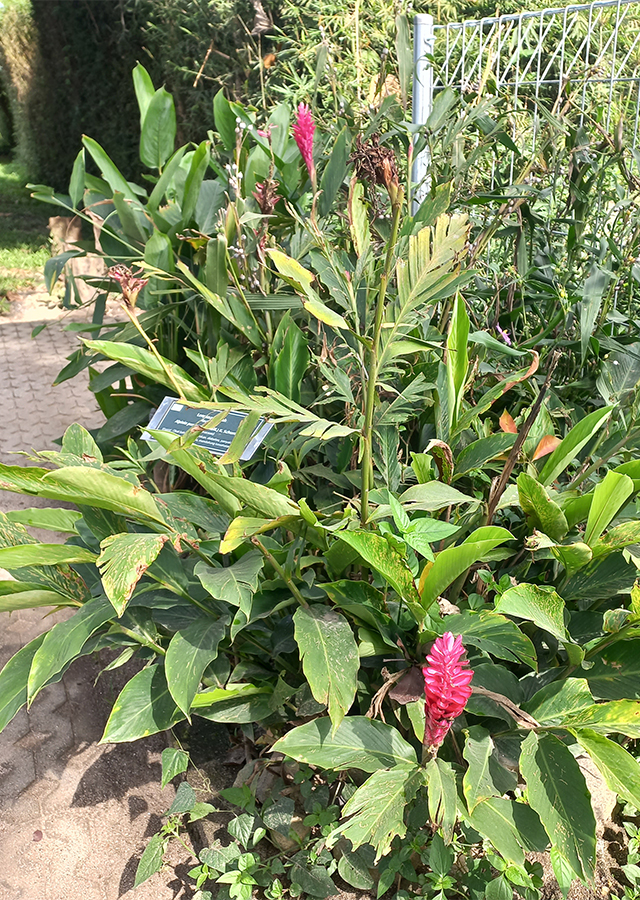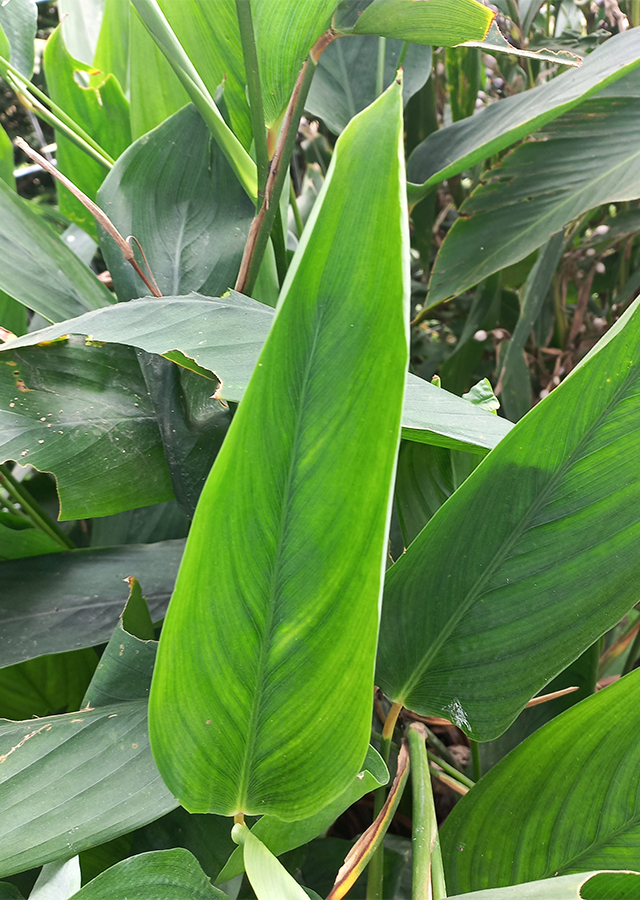Traditional Herbs from Alpinia purpurata
flatulent_disorder
- Take 1 finger of red galangal rhizome, wash it until clean.
- Slice the rhizome thinly then boil it in 3\u00a0glasses of water to make 2 glasses of water.
- Strain then drink in the morning and evening before each meal -still 1 glass.
panu
- Prepare 1 finger segment of fresh red galangal rhizome, wash until clean.
- Cut the rhizome at an angle then beat the tip until it looks like a brush.
- Rub\u00a0on tinea versicolor.
What is Alpinia purpurata Looks like??



Parts of Alpinia purpurata that could be used
- Leaves", "Flowers", "Fruits", "Stems", "Rhizomes
Alpinia purpurata Distribution
Red galangal originates from eastern Indonesia to Papua New Guinea and the Southwest Pacific (New Caledonia, Solomon Islands and Vanuatu). This plant has been widely introduced and cultivated as an ornamental plant and cut flower in tropical areas. This plant is also a type of spice that has many health benefits and is widely used in phytopharmaceutical products. In its use by the community, red galangal has been used since ancient times to remove white spots such as tinea versicolor on the skin by applying pieces of galangal to the diseased part of the body. This is confirmed by the results of studies which show that this plant contains active essential oils and has antifungal and antibacterial properties. Apart from that, red galangal leaves can be used as a yellow dye.Agroecology of Alpinia purpurata
Under natural conditions, red galangal can be found in secondary forests, damp roadsides, river banks, mangrove swamp edges, wetlands, lowland to medium forests, at altitudes up to around 500 m above sea level. Red galangal generally grows well in humid habitats with warm temperatures and high rainfall. Average annual rainfall ranges from 800-4,000 mm. It grows best in partially shaded areas, but is also adaptable to open areas with full sun. Its growth prefers soil that is fertile, loose, contains lots of humus, is aerated and has good drainage, and is not waterlogged.
Morphology of Alpinia purpurata
- The roots have aromatic rhizomes, spreading in thick clusters, producing aerial shoots when the older shoots dry out. The rhizomes are large, thick, fleshy, cylindrical, branched, the outside is slightly reddish brown with reddish scales, hard shiny, while the inside of the rhizome is white. The flesh of the old rhizome has coarse fibers and a sharp, spicy taste.
- Wet stems (herbaceous),\u00a0erect, composed of the leaf midribs unite to form a false stem, slightly whitish green in color. The young stem emerges as a shoot from the base of the old stem.
- Single leaves, arranged\u00a0alternately, elongated lanceolate shape, green, glabrous ), pinnate leaf spines, short pointed tip, flat edge, no stem, pubescent, long midrib wraps around the stem, pubescent at the apex and along the edge of the midrib.
- Flowers small, compound, arising from red bracts. Bracts ovate to obovate, primary bracts usually red,\u00a0ovate or broadly ovate,\u00a0bracteoles reddish,\u00a0tubular.\u00a0Petal reddish, glabrous, each lobe with subapical spur. The crown is\u00a0white, forming a cone, funnel or tube, appearing just outside the primary bracts. Stamens 6-7 mm long. The inflorescences are in bunches, located at the terminal stem, unbranched.
- Fruits are almost round capsules, 2-3 cm in diameter, hard. Young fruit is green-yellow, when mature it turns black-brown and splits when ripe.
- Seeds are round, ribbed, about 0.2 cm long, black, have a seed coat, oily.
Cultivation of Alpinia purpurata
Propagation can be done using seeds and dividing rhizomes.
Alpinia purpurata, more details :
Chemical Content of Alpinia purpurataKumatakenin, stiosteril-3-O-6-palmitoyl-ß-D-glucoside, ß-sitosteryl galactoside, essential oils (α-pinene, ß-pinene, ß-caryophyllene, camphene, 7-epi-α-selinene, 1.8 cineol, kavikol acetate, methylcinnamate, galangin, eugenol, cis β-farnesen, 1-β-bisabolen, β-elements), alkaloids, terpenoids, steroids, cardioglycosides, tannins, 4-morpholinomethyl-7-methoxycoumarin, methanesulfonate (3R,4S)-3-propargyloxy -4-[(R)-1-hydroxy-3-phenyl- 3-butenyl]-1-(p-methoxyphenyl)-2-azetidinone, 5-butyl-3-methyl-1,2,3, 8a-tetrahydroindolizine, phenol, 4-(3,7-dimethyl-3-ethenilocta- 1,6-dienyl)-, methenolone, nonanamide, 5-hydroxy-5-methyl-2-(2-methylpropyl)-N-benzyl-, flavonoid kaempferol-3-O-glucuronide, routine.
Benefits of Alpinia purpurata
Treats stomach aches, colds, skin diseases (tinea versicolor), headaches, wounds, cough symptoms, ear inflammation, bronchitis, pain reliever, has anti-inflammatory, antioxidant, anti-fungal, anti-bacterial and anti-cancer activity.
Simplisia of Alpinia purpurata
Another Facts for Alpinia purpurata :
Synonym of Alpinia purpurataAlpinia grandis K.Schum., Guillainia purpurata Vieill., Languas purpurata (Vieill.) Kaneh.
Habitus of Alpinia purpurata
Herb. An annual erect herb, growing up to 4 m tall
Habitat of Alpinia purpurata
- Wetland
- Riverside
- Forest
- Land
No comments:
Post a Comment